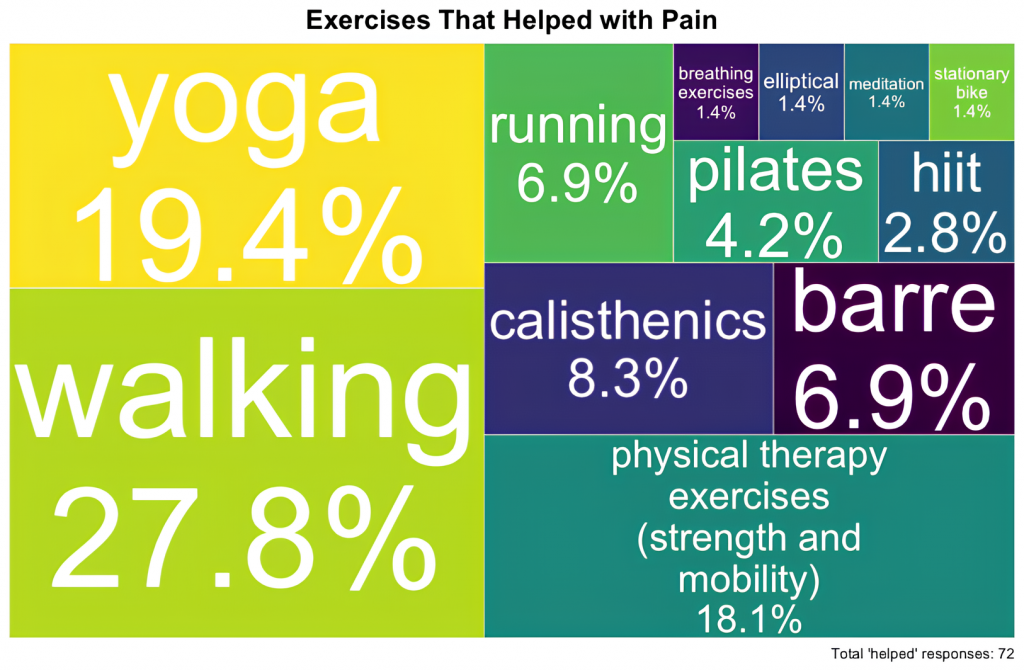This month, we bring to you insights from the Phendo App that is used as a part of our CPP Tracker study. Phendo was developed by our collaborators at Columbia University and aims to empower participants to contribute directly to the scientific understanding of their conditions while simultaneously gaining insights into their own health. You can read more about its aims and the great from the Citizen Endo Team on their website.
And with this intro, let’s move onto this month’s insights:
Daily Exercise and Pain Patterns:
Managing chronic pain can feel like an uphill battle, but movement might be a powerful tool to help. We were curious to explore the various exercise types and their symptom relief effects reported by the participants. Within the Phendo App, daily exercise is tracked using “Did you do any exercise today?”, followed by “Did it have any effect on your symptoms?”. The tile chart below highlights all exercise instances reported as “helpful” across the study sample and duration to date.

First, we notice a variety of exercise types our participants engage in, with the most frequent categories depicted in this tile chart. Walking emerged as the most frequently beneficial activity, accounting for nearly 28% of all helpful responses. Yoga followed at 19%, and strength and mobility exercises—often reported as part of physical therapy—came in third at 18%. Beyond these top three, participants also found relief through activities like calisthenics, pilates, and running.
Making Sense of the Trends:
There could be various reasons for these trends. For example, it is possible that the accessibility of walking in particular makes it a practical first option for many. This finding aligns with broader research suggesting that gentle, low-impact aerobic activity can reduce pain sensitivity and improve overall function in chronic pain conditions.
Yoga follows as the second most reported beneficial activity, comprising approximately 19% of helpful exercise reports. Yoga is considered a multi-modal exercise as it can include aerobic, strength, stretching, and balance components. Moreover, its emphasis on gentle stretching, controlled breathing, and mindfulness, could be contributing to its popularity. Yoga’s adaptability to different ability levels may also explain its high ranking among participants.
Physical therapy including mobility and strength exercises round out the top three at 18% of helpful exercise reports. These typically involve personalized, targeted movements to address specific functional limitations or pain triggers. This customized approach may explain why participants find it particularly beneficial.
The Diversity of Helpful Activities:
At the same time, the diversity of helpful activities reminds us that there is no one-size-fits-all solution for pain management. The presence of higher-intensity activities like running among the helpful exercises challenges the common assumption that people with chronic pain conditions should avoid vigorous activity. Though more research is needed to understand why and how it might be helpful for some. Nevertheless, the variety indicates that participants likely find different types of movement beneficial depending on their individual circumstances, symptom patterns, and personal preferences. Of course, it is advised to consult with your health provider for personalized recommendations specific to your unique needs.
Closing Thoughts:
As our study continues, we hope to refine our understanding of how our participants engage in physical activity and exercise in the context of their health and symptoms over time. By identifying patterns related to specific types of pain or contextual factors, we move closer to developing personalized approaches that empower individuals to live well whilst managing chronic conditions.
A Heartfelt Thank You:
None of these insights would be possible without the generosity of our participants. Your willingness to share your experiences is building a roadmap for better pain management—one that respects individual needs and celebrates small victories. We’re deeply grateful to collaborate with you in this vital work. Stay tuned for future updates and thank you for being part of this important conversation!
Tweet